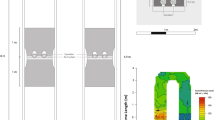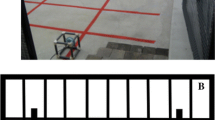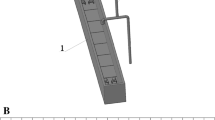Abstract
Four species of invasive carp from Asia are currently advancing up the Mississippi River through its locks and dams. It has been hypothesized that this movement could be blocked in a selective manner by projecting sound projected into locks because carp, like all members of the Ostariophysi, have exceptional hearing. Although previous laboratory studies have shown that a broadband cyclic sound blocks ~ 80% of bighead and common carp, and that this value increases when sound is projected into an air curtain to create an ensonified bubble curtain (EBC), the effectiveness of EBCs at blocking other fishes including carps has not been addressed. To answer this question, the present study examined the responses of 10 fishes including 4 species of invasive carp (bighead, silver, grass, common), 2 native ostariophysians (channel catfish, golden shiner), and 4 native non-ostariophysians (rainbow trout, largemouth bass, bluegill sunfish, lake sturgeon) in a laboratory flume while a cyclic sound was either projected on its own or into a bubble curtain. The EBC, whose sound fields (sound pressure and particle acceleration) were more intense and sharper than sound alone, blocked all 4 carps 92–97% of the time for all 8 trials (i.e. without apparent habituation), while 5 native ostariophysian and non-ostariophysian fishes were also partially blocked 19–89%. In contrast, sound alone significantly blocked only bighead and common carp while affecting the other fishes including the carps to varying extents (− 44–7%). In conclusion, EBCs appear very well suited to block carps.




Similar content being viewed by others
Data availability
Data are available from the authors upon request and also from the University of Minnesota data archive site (DRUM). https://conservancy.umn.edu/handle/11299/166578/discover?query=Feely
References
Asian Carp Regional Coordinating Committee (ACRCC) (2021) Asian carp action plan. Available at https://www.asiancarp.us/
Banet NV, Fieberg J, Sorensen PW (2021) Migration, homing and spatial ecology of common carp in interconnected lakes. Ecol Fresh Fish 30:164–176. https://doi.org/10.1111/eff12622
Brevik I, Kristiansen O (2002) The flow in and around air-bubble plumes. Int J Multiph Flow 28:617–634
Bzonek PA, Van Nynatten KJ, Mandrak NE (2021a) Phylogenetic signal found in fish–community response to an acoustic common carp deterrent. Freshwater Biol 66:1698–1708
Bzonek PA, Kim J, Mandrak NE (2021b) Individual variation influences avoidance behaviour of invasive common carp (Cyprinus carpio) and native buffalo (Ictiobus) to stroboscopic and acoustic deterrents. Mar Fresh Res 72:1682–1688
Chapman DC, Hoff MH (2011) Invasive Asian carps in North America. American Fisheries Society, Bethesda
Claus A, Sorensen PW (2019) Chemical cues which include amino acids mediate species-specific feeding behavior in invasive filter-feeding bigheaded carps. J Chem Ecol 43:374–384
Cooper AR, Brumm KJ (2021) Prioritizing native migratory fish passage restoration while limiting the spread of invasive species: a case study in the Upper Mississippi River. Sci Total Environ 791:100–114
Cudmore B, Mandrak N (2004) Biological synopsis of grass carp (Ctenopharyngodon idella). Can Manuscr Rept Fish Aquat Sci 2705:1
Cupp AR, Brey MB, Calfee RD, Chapman DC, Erickson R, Fischer J, Fritts AK, George AE, Jackson RP, Knights BC, Saari GN, Kocovsky (2022) Emerging control strategies of integrated pest management of invasive carps. J Vert Biol 70:1–21
DeGrandchamp KL, Garvey JE, Colombo RE (2008) Movement and habitat selection by invasive Asian carps in a large river. Trans Am Fish Soc 137:45–56
Dennis CE, Sorensen PW (2020a) Common carp are initially repelled by a broadband outboard motor sound in a lock chamber but habituate rapidly. N Am J Fish Manag 40:1499–1509
Dennis CE, Sorensen PW (2020b) High-intensity light blocks Bighead Carp in a laboratory flume. Manag Biol Invas 11:441–460
Dennis CE, Zielinski DP, Sorensen PW (2019) A complex sound coupled with an air curtain blocks invasive carp passage without habituation in a laboratory flume. Biol Invas 21:2837–2855
Dominico SN (1982) Acoustic wave propagation in air-bubble curtains in water, part 1: history and theory. Geophysics 37:345–353
Dong S, Li D (1994) Comparative studies on the feeding selectivity of silver carp Hypophthalmichthys molitrix and bighead carp Aristichthys nobilis. J Fish Biol 44:612–626
Embke H, Kocovsky P, Richter C, Pritt J, Mayer C, Qian S (2016) First direct confirmation of grass carp spawning in a Great Lakes tributary. J Great Lakes Res 42:899–903
Fay R, Tavolga W (2012) Sensory biology of aquatic animals. Springer, Berlin
Feely J (2020) The ability of a cyclic sound on its own and when coupled with an air curtain to block 10 species of fish including carp in a laboratory flume. Unpublished MS thesis, University of Minnesota, St Paul
Fine M, McElroy D, Rafi J, King C, Loesser K, Newton S (1995) Lateralization of pectoral stridulation sound production in the channel catfish. Physiol Behav 60:753–757
Fritts AK, Knights BC, Stanton JC, Milde AS, Vallazza J, Brey M, Tripp S, Devine TE, Sleeper W, Lamer JT, Mosel KJ (2021) Lock operations influence upstream passages of invasive native fishes at a Mississippi River high-head dam. J Biol Invas 23:771–794
Harris C, Brenden T, Vandergoot C, Faust M, Herbst S, Krueger C (2021) Tributary use and large-scale movements of grass carp in Lake Erie. J Great Lakes Res 47:48–58
Hawkins AD, Popper AN (2018) Directional hearing and sound source localization by fishes. J Acoust Soc Am 144:3329–3350
Holt DE, Johnston C (2011) Hearing sensitivity in two black bass species using the auditory brainstem response approach. Environ Biol Fish 91:121–126
Kolar C, Chapman D, Courtenay W, Housel C, Williams J, Jennings D (2007) Bigheaded carps: a biological synopsis and environmental risk assessment. American Fisheries Society, Bethesda
Ladich F, Fay RR (2013) Auditory evoked potential audiometry in fish. Rev Fish Biol Fish 23:317–364
Lamer JT, Dolan CR, Petersen JL, Chick JL, Epifanio JM (2010) Introgressive hybridization between bighead and silver carp in the Mississippi and Illinois rivers. N Am J Fish Manage 30:1452–1461
Leighton TG (2012) The acoustic bubble. Academic Press, London
Leighton TG, Richards SD, White PR (2004) Trapped within a “wall of sound.” Accoust Bull 29:24–29
McCullagh P, Nelder J (1989) Binary data: generalized linear models, Springer, pp 98–148
Murchy K, Vetter B, Brey M, Amberg J, Gaikowski M, Mensinger A (2016) Not all carp are created equal: impacts of broadband sound on common carp swimming behavior. In: Proceedings of meetings on acoustics 4ENAL, vol 27, no 1, Acoustical Society of America, p 010032
Nico L, Jelks H (2011) The black carp in North America: an update. Am Fish Soc Symp 74:89–104
Perry RW, Romine JG, Adams NS, Blake AR, Burau JR, Johnston SV, Liedtke TL (2012) Using a non-physical behavioural barrier to alter migration routing of juvenile chinook salmon in the Sacramento-San Joaquin River delta. River Res Appl 30:192–203
Popper AN, Carlson T (1998) Application of sound and other stimuli to control fish behavior. Trans Am Fish Soc 127:673–707
Popper AN, Hawkins AD (2018) The importance of particle motion to fishes and invertebrates. J Acoust Soc Amer 144:470–488
Popper AN, Hawkins AD (2019) An overview of fish bioacoustics and the impacts of anthropogenic sounds on fishes. J Fish Biol 94:692–713
Putland R, Mensinger A (2019) Acoustic deterrents to manage fish populations. Rev Fish Biol Fish 29:789–807
Rankin CT, Abrams R, Barry S, Bhatnagar D, Clayton J, Colombo G, Coppola M, Geyer D, Glanzman S, Marsland F, McSweeney F (2009) Habituation revisited: an updated and revised description of the behavioral characteristics of habituation. Neurobiol Learn Mem 92:135–138
Reeves A (2019) Overrun: dispatches from the Asian Carp Crisis. ECW Press, Toronto
Riesgraf A, Finger J, Zielinski D, Dennis C, Whitty J, Sorensen PW (2022) Evaluation of a broadband sound projected from the gates of a navigation lock in the Mississippi River shows it to be a weak deterrent for common carp and unable to block passage. Man Biol Invas 13:220–232
Ruebush B, Sass G, Chick J, Stafford J (2012) In-situ tests of sound-bubble-strobe light barrier technologies to prevent range expansions of Asian carp. Aquat Invasions 7:37–48
Sorensen PW, Bajer PB (2011) Common carp. In: Biological invasions, no. 3. Berkley and Los Angeles editors: University of California Press
Stell E, Hoover J, Fuller L, Parsons G (2019) Analyzing leap characteristics and water escape velocities of Silver Carp using in situ video analysis. N Am J Fish Manag 40:163–174
Suski CD (2020) Development of carbon dioxide barriers to deter invasive fishes: insights and lessons learned from bigheaded carp. Fishes 5(3):25
Taylor RM, Pegg MA, Chick JH (2005) Response of a bighead carp to a bioacoustics behavioural fish guidance system. Fish Manag Ecol 12:283–286
Vetter BJ, Cupp AR, Fredricks KT, Gaikowski MP, Mensinger AF (2015) Acoustical deterrence of silver carp (Hypophthalmichthys molitrix). Biol Invas 17:3383–3392
Vetter BJ, Brey MK, Mensinger AF (2018) Reexamining the frequency range of hearing in silver (Hypophthalmichthys molitrix) and bighead (H. nobilis) carp. PLoS One 13:0192561
Wamboldt JJ, Murchy KA, Stanton JC, Blodgett KD, Brey MK (2019) Evaluation of an acoustic fish deterrent system in shallow water application at the Emiquon Preserve, Lewistown, IL. Man Biol Invas 10:536
Warren ML, Burr BM (2014a) Freshwater fishes of North America. Johns Hopkins Press, Baltimore
Warren ML, Burr BM (2014b) Freshwater fishes of North America (eds), vol 1, Johns Hopkins Press
Welton JS, Beaumont WRC, Clarke RT (2002) The efficacy of air, sound, and acoustic bubble screens in deflecting Atlantic salmon, Salmo salar L., smolts in the River Frome, UK. Fish Manag Ecol 9:11–18
Whitty JM, Riesgraf AT, Zielinski DM, Sorensen PW (2022) Movements of a model fish, the common carp, through a generic Mississippi River lock and dam demonstrate how fish swimming performance, behavior, and discharge-driven flow-fields determine fish passage rates in ways that can be predicted and modified using fish passage models. Riv Res Appl 38:670–683
Zielinski DP, Sorensen PW (2016) Field test of a bubble curtain deterrent system for common carp. Fish Manag Ecol 22:181–184
Zielinski DP, Sorensen PW (2017) Silver, bighead, and common carp orient to acoustic particle motion when avoiding a complex sound. PLoS ONE 12:e0180110
Zielinski DP, Sorensen PW (2021) Numeric simulation demonstrates that the upstream movement of invasive bigheaded carp can be blocked at sets of Mississippi River locks-and-dams using a combination of optimized spillway gate operations, lock deterrents, and carp removal. Fishes 6:10. https://doi.org/10.3390/fishes6020010
Zielinski DP, Voller VR, Svendsen JC, Hondzo M, Mensinger AF, Sorensen PW (2014) Laboratory experiments demonstrate that bubble curtains can effectively inhibit movement of common carp. Ecol Eng 67:95–103
Zielinski DP, Voller VR, Sorensen PW (2018) A physiologically inspired agent-based approach to model upstream passage of invasive fish at a lock-and-dam. Ecol Model 382:18–32
Acknowledgements
We thank the Minnesota Aquatic Invasive Species Research Center for helping administer the project and providing laboratory space. Dr. Andy Turnpenny provided technical advice on the laboratory equipment which was leased from Fish Guidance Systems Ltd. without conditions or any expectation of what the results might be. Clark Dennis provided invaluable help with the experimental design, protocols, data and sound analysis. Dan Zielinski advised on the propagation of sound fields. Help with statistical design and analyses was provided by the University of Minnesota’s Institute for Research on Statistics and its Applications Statistical Consulting Center (Dr. Gary Oehlert). Dan Krause, Rosie Daniels, Kirsten Engseth, Kory Davis, Pheng Lor, Laura Wagner. Austin Abbott, Nicholas Jacob, and Kara Van Lerberghe provided invaluable help with fish husbandry, running experiments. Three anonymous reviewers and an associate editor provided many helpful suggestions.
Funding
Funding for this project was provided by the Minnesota Environmental and Natural Resources Trust Fund as recommended by the Legislative-Citizen Commission for Minnesota Resources (LCCMR).
Author information
Authors and Affiliations
Contributions
This research was conceived by PS who also acquired the funding and edited final drafts of the manuscript. Data collection and analysis was performed by JF who wrote the first drafts of the manuscript.
Corresponding author
Ethics declarations
Conflict of interest
Not applicable.
Ethics approval
Procedures were approved by the University of Minnesota Institutional Animal Care and Use Committee (Protocol: 1712-35381A).
Additional information
Publisher's Note
Springer Nature remains neutral with regard to jurisdictional claims in published maps and institutional affiliations.
Supplementary Information
Below is the link to the electronic supplementary material.
Rights and permissions
Springer Nature or its licensor (e.g. a society or other partner) holds exclusive rights to this article under a publishing agreement with the author(s) or other rightsholder(s); author self-archiving of the accepted manuscript version of this article is solely governed by the terms of such publishing agreement and applicable law.
About this article
Cite this article
Feely, J.R., Sorensen, P.W. Effects of an ensonified bubble curtain and a cyclic sound on blocking 10 species of fishes including 4 invasive carps in a laboratory flume. Biol Invasions 25, 1973–1989 (2023). https://doi.org/10.1007/s10530-023-03022-6
Received:
Accepted:
Published:
Issue Date:
DOI: https://doi.org/10.1007/s10530-023-03022-6




